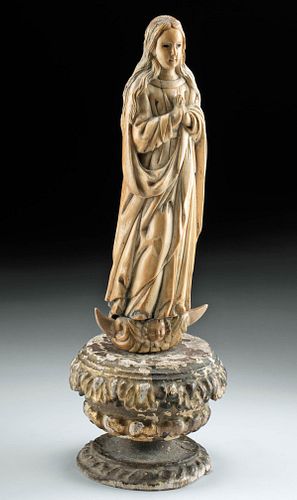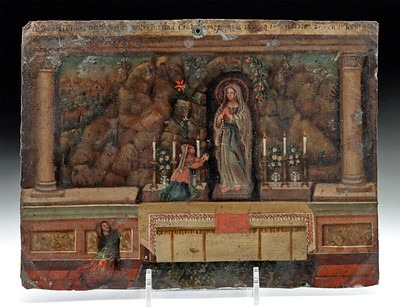18th C. Indo-Portuguese Ivory Statuette of Mary
Lot 73
About Seller
Artemis Gallery
686 S Taylor Ave, Ste 106
Louisville, CO 80027
United States
Selling antiquities, ancient and ethnographic art online since 1993, Artemis Gallery specializes in Classical Antiquities (Egyptian, Greek, Roman, Near Eastern), Asian, Pre-Columbian, African / Tribal / Oceanographic art. Our extensive inventory includes pottery, stone, metal, wood, glass and textil...Read more
Estimate:
$4,000 - $6,000
Absentee vs Live bid
Two ways to bid:
- Leave a max absentee bid and the platform will bid on your behalf up to your maximum bid during the live auction.
- Bid live during the auction and your bids will be submitted real-time to the auctioneer.
Bid Increments
| Price | Bid Increment |
|---|---|
| $0 | $25 |
| $300 | $50 |
| $1,000 | $100 |
| $2,000 | $250 |
| $5,000 | $500 |
| $10,000 | $1,000 |
| $20,000 | $2,500 |
| $50,000 | $5,000 |
| $100,000 | $10,000 |
| $200,000 | $20,000 |
About Auction
By Artemis Gallery
Jun 15, 2023
Set Reminder
2023-06-15 10:00:00
2023-06-15 10:00:00
America/New_York
Bidsquare
Bidsquare : VARIETY Ancient, Ethno, Native American, Fine Art
https://www.bidsquare.com/auctions/artemis-gallery/variety-ancient-ethno-native-american-fine-art-12990
Antiquities, ethnographic, native american and fine art from cultures encompassing the globe. Artemis Gallery info@artemisgallery.com
Antiquities, ethnographic, native american and fine art from cultures encompassing the globe. Artemis Gallery info@artemisgallery.com
- Lot Description
South Asia, western India, Ceylon (modern-day Sri Lanka) or Goa, Indo-Portuguese culture, ca. 18th century CE. A beautiful ivory carving of the Virgin of the Immaculate Conception depicted draped in long robes as she holds her hands together in prayer and stands atop a crescent moon - a reference to the Book of the Apocalypse in the New Testament - and the winged head of a cherub, all supported by a 20th-century gilt and gessoed wooden base. The province of Goa in western India was under Portuguese control from 1512–1961, forming a nexus in trading routes that circumnavigated the earth. Goan craftsman were renowned for their supple modeling of ivory (likely exported from Mozambique) into Christian icons, which feed the appetite for luxury products in Europe, as well as furthered evangelical missions throughout Asia and the Americas. Size: 3.6" W x 9.3" H (9.1 cm x 23.6 cm) Size: 4.5" W x 12.9" H (11.4 cm x 32.8 cm)
According to the Victoria and Albert Museum, "Ivory sculptures were locally produced in large numbers in Portuguese Sri Lanka (formerly called Ceylon). Usually for an European clientele, their style of carving combines Indian or Sri Lankan with European traditions...From the sixteenth-century, the Portuguese were active as traders and later as rulers in Sri Lanka and Goa (on the west coast of India). Ivory carving had a long tradition on the Indian subcontinent, and elaborate works of art were made, particularly as diplomatic gifts, often presented to Western rulers. Most of the ivory would have been exported from Mozambique in East Africa. Ivory sculptures were produced in large numbers in Portuguese Sri Lanka (formerly called Ceylon). The Virgin Mary was often standing on the crescent moon, triumphant over a dragon, both symbols derived from the Book of the Apocalypse in the New Testament.. From the sixteenth century onwards, the four main missionary Orders, the Augustinians, Jesuits, Dominicans and Franciscans, built churches and aimed to convert the inhabitants of India. The ivories would assist in the presentation of Christian imagery, as well as being exported back to churches, convents and private collectors in Europe."
This is an ESA antique exempt piece of ivory and cannot be sold internationally or to anyone residing in the states of California, Hawaii, Illinois, Nevada, New Hampshire, New Jersey, New York, Oregon, and Washington. We guarantee that the piece is over 100 years old.
Provenance: private Rancho Mirage, California, USA collection; ex-Terry Barreth collection, before 1965
All items legal to buy/sell under U.S. Statute covering cultural patrimony Code 2600, CHAPTER 14, and are guaranteed to be as described or your money back.
A Certificate of Authenticity will accompany all winning bids.
We ship worldwide and handle all shipping in-house for your convenience.
#17907618th-century ivory sculpture on 20th-century wood base. Missing inlaid eyes. Virgin, cherub, and crescent moon are carved from separate pieces of ivory with some small areas of visible adhesive. Losses to Mary's little fingers, as well as nicks and abrasions and natural fissures to ivory. Weathering to wood base with chipping and losses to gesso and gilding. Nice remaining detail on Mary and rich encrustations in recessed areas. Part of hair has been sculpted separately and attached to head in order for insertion of glass eyes.Condition
- Shipping Info
-
All shipping is handled in-house for your convenience. Your invoice from Artemis Gallery will include shipping calculation instructions. If in doubt, please inquire BEFORE bidding for estimated shipping costs for individual items.
-
- Buyer's Premium



 EUR
EUR CAD
CAD AUD
AUD GBP
GBP MXN
MXN HKD
HKD CNY
CNY MYR
MYR SEK
SEK SGD
SGD CHF
CHF THB
THB














